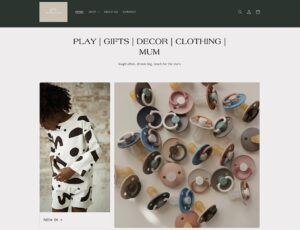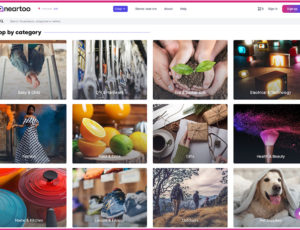
Marc Swann, search director at digital marketing agency Glass Digital, has over 12 years’ experience in the world of online marketing. He has overseen digital campaigns for a number of major UK fashion retailers including House of Fraser, Terry de Havilland and Pritchards. In this article, he explains how you to give your childrenswear business an edge over its competitors online.
There’s no doubt that ecommerce is the future of retail. The first page of the Google results is essentially the new high street for many shoppers, with 18% of all retail purchases now being made online (ONS).
And, while that presents a great opportunity for businesses looking to make a sale, it does mean that the digital landscape is incredibly competitive. Hundreds — or even thousands — of clothing brands are all vying for the attention of online shoppers.
So, just how can you make your brand stand out, especially if you’re up against major retailers with huge marketing budgets? Here, I’ll explain how you can give your brand the best chance of success.
Prioritise spending on your website
When you’re competing with hundreds of other childrenswear retailers for clicks, it’s essential that you have a really great website. If you have a well-designed, stylish site that provides a user-friendly experience, then your visitors are simply much more likely to stay on site and buy from your business.
A site for a clothing brand should be easy to navigate. Plus, plenty of high-quality, professional photos of your products. You should also make sure that any USPs like free delivery, flexible payment options, special offers or discounts are displayed prominently in your onsite copy. You’re competing against every other kids’ clothing brand on the internet, so tell your customers why they should be shopping with you!
If you’re serious about getting your business on the front page of the Google results for your key terms, then you’ll need a more comprehensive search engine optimisation (SEO) strategy. You can outsource this work to an SEO specialist or agency. They will be able to use industry tools to optimise your onsite content and increase traffic to your site.
Make the most of social media
Social media channels are an essential tool for any fashion brand; especially visual-led platforms like Instagram. These offer an excellent opportunity to showcase your products and engage directly with your customers. They also help your target audience to discover your business.
For success on Instagram, you need to take high-quality, well thought out photographs. Also, research your hashtags with care and ensure you have a coherent theme that fits the aesthetic of your brand.
While showcasing your products is important, every post shouldn’t be advertorial. Posts that offer your followers a ‘behind the scenes’ glimpse into your business can be great for engagement, too.
You should also be sure to publicise your social channels in your other marketing. This enables customers to tag you in any posts they create about your products. You can then share these with your followers (provided you get their permission first, of course).
While social media is completely free to use, it’s well worth allocating some marketing budget for social campaigns. Facebook and Instagram offer advertising packages that give you the option to ‘boost’ your posts. This means they will appear in the feeds of your target customers. You can even make your Instagram feed shoppable to help drive conversions. Visit Instagram’s help centre to learn more about this.
Work with bloggers and influencers
Partnering with bloggers and social media influencers can be a very successful way to connect with your target customers, gain exposure and promote your products. As a childrenswear retailer, so-called ‘mummy bloggers’ — influencers with a family focus — are likely to be your best target; their audience is the demographic most likely to take an interest in your products.
So, you should consider reaching out to influencers with a reasonable following to secure some exposure, possibly in the form of a product review or advertising partnership. If you’re offering a product, be sure to give them something that you have plenty of. That way you can meet the rise in demand that will (hopefully) result from the extra publicity.
Remember, many influencers (especially those with larger followings) will ask for payment in exchange for marketing your products. This will need to be disclosed in their posts to meet the standards set by the ASA. Depending on the value of the partnership or products offered, it may also be a good idea to sign a contract so the terms of your deal are clear.
Use Google tools
A Google My Business listing will make sure your physical store appears on Google Maps, which can help you attract local searchers. It also makes your company seem more established and credible, which can help improve your rankings on Google and drive sales. Updating your listing is quite easy to do; you just need to fill out the information on your business account. Fill out as much information as you can, as this will ensure the best results.
Save time by hiring a professional
As a business owner, it can be tough to find the time to devote to your website and online marketing in the early days. This is particularly true if you already have a bricks and mortar outlet that takes up most of your time. The solution is to delegate and outsource work when you can.
As ecommerce becomes more and more important, it’s certainly worth considering hiring a marketer or outsourcing some of your workload to a social media or digital marketing agency. Not only will this save you time, but you’ll benefit from the expertise of an experienced team of professionals, too.
While this will require a chunk of your budget, it can be essential to the success of the ecommerce side of your business. If you’re just getting started, devote a small amount of your budget to your digital marketing initially. Then gradually scale up as the business grows.
The world of ecommerce can be quite intimidating for a young brand. However, given that online shopping is becoming more and more popular, it’s definitely worth spending some time on your digital marketing.
Take these tips on board to gain exposure and help your kids’ clothing business stand out from all the other retailers out there.












